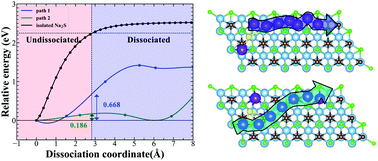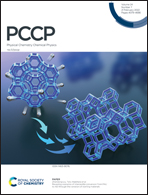Two-dimensional titanium carbide (Ti3C2Tx) MXenes to inhibit the shuttle effect in sodium sulfur batteries†
Abstract
Room-temperature sodium sulfur batteries (RT-NSBs) are among the promising candidates for large-scale energy storage applications because of the natural abundance of the electrode materials and impressive energy density. However, one of the main technical challenges of RT-NSBs is the shuttle effect by which active redox intermediates (i.e., sodium polysulfides Na2Sn, n = 1–8) are dissolved in electrolytes, which hamper the battery reversibility. The interfacial interplays between Na2Sn and the electrodes (or electrolytes) at the atomic level thus play an intrinsic role in elucidating the shuttle effect. This work reports the ab initio calculations to unravel the suppression of the shuttle effect using titanium carbide MXenes (Ti3C2Tx, Tx = F, O) as the cathode additives. The findings reveal that the shuttle phenomenon is efficiently resolved because the immense chemical bonding of Na2Sn–Ti3C2Tx interfaces competitively surpasses the binding magnitudes of Na2Sn–electrolyte interaction. The analysis of the electronic density of states and charge density further manifests that there is charge donation from the Na-3s orbital of Na2Sn to the unfilled F(O)-2p orbitals of metallic Ti3C2Tx. The metallicity of the Ti3C2Tx remains preserved during the entire course of the redox process, ensuring the rapid electrochemical kinetics. Furthermore, the presence of Ti3C2Tx additives drastically reduces the dissociation barrier of the final redox product Na2S, yielding the efficient utilization of sulfur during the discharge process. This work has proposed the unexplored functionality of Ti3C2Tx as the anchoring materials for RT-NSBs.

- This article is part of the themed collection: 2022 PCCP HOT Articles


 Please wait while we load your content...
Please wait while we load your content...